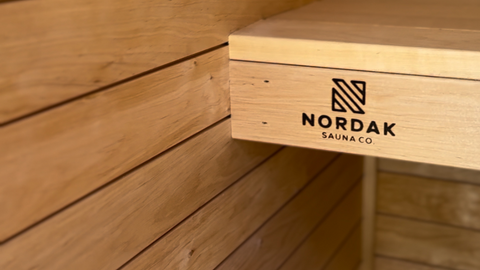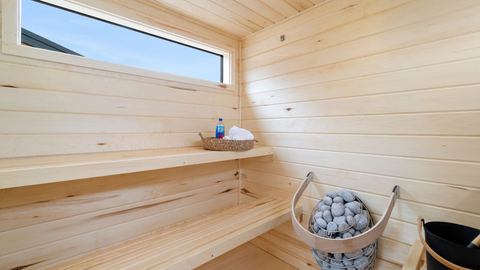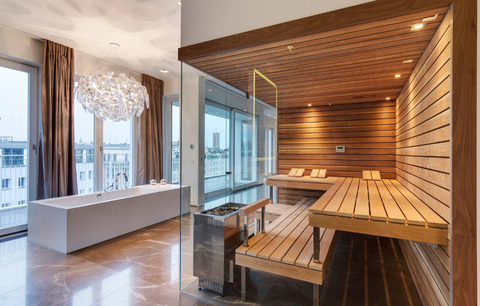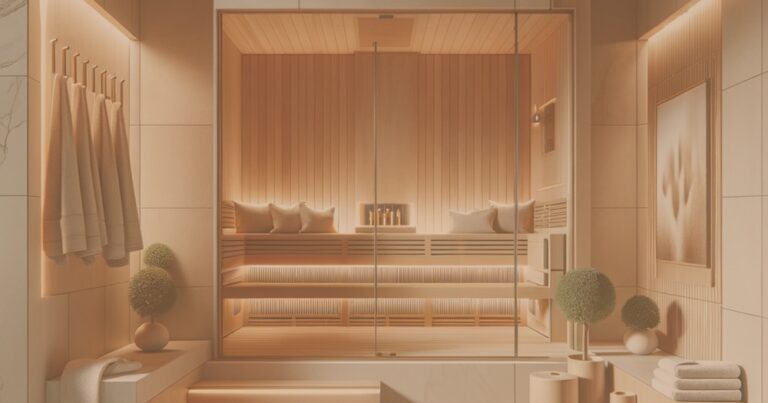Sauna is an excellent therapy for your body as it offers several health advantages. It relaxes tight muscles, improves circulation of blood, and helps you sleep better. And guess what? Constructing your very own sauna is not as complicated as one would imagine.
You are in charge of every small detail when you build your own custom indoor sauna. Everything is up to you — style, materials, and hi-tech features. You can even customize the look of your sauna to complement your home’s theme and style perfectly.
Designing your unit from scratch allows you to create a relaxing retreat that feels like an extension of your home rather than an afterthought. That’s the power of going custom!
This guide will lead you through the whole process of building your perfect indoor sauna. First, we must know precisely what you need, pick design options, and choose the best material.
So, let’s design you a sauna!

Planning and design
Creating custom indoor sauna for your home begins with meticulous planning and a dash of imagination. Let’s dive into the specifics of this aspect of the process:
Picking the location
Choosing a spot for your indoor sauna is one of the most crucial decisions in the whole process. You need a spot where you can escape and relax, away from the hustle and chaos of your house.
Many people prefer basements to install their units for this very reason.
Basements have an added advantage in that they are already set up to handle extra moisture. So, it can be a good place for your project.
But, hey, if the basement sounds too out-of-the-way, a bathroom is a great second choice.
If you have a big enough bathroom, you can transform a part of it to install your sauna.
Besides, the bathroom already has everything you will need, and it is moisture-resistant as well. So, a win-win situation here.
Or, if you are lucky enough to have some extra space, why not dedicate a whole room to your sauna? Imagine having a personal relaxation room right at home!
If there’s more room in the backyard than the basement, check out this guide to backyard saunas: Elevating Your Backyard Experience
Whatever you decide, just make sure that the location you pick can handle the heat and humidity.

Size and layout
Ask yourself this: will the sauna be for my personal retreat, or am I planning to entertain guests?
The answer to this question will determine the size of your custom sauna. A personal sauna can be a small unit that is perfect for one or two people.
However, if you plan to invite guests to unwind in your sauna, you might need to consider a bigger unit.
Here is a general guideline of the dimensions of a home sauna:
- For solo relaxation: 4 ft. X 4 ft.
- For accommodating groups: 8 ft. X 12 ft.
Remember, these are just suggestions; you can always have even bigger indoor or outdoor saunas if you would like!
Now, you should also keep in mind that the large units will obviously need more space and upfront costs to build.
Also, maintaining and operating larger units is more expensive and resource-intensive.
You want your sauna to be comfortable and welcoming at the same time. The last thing you want is to have a cramped room that is uncomfortable to sit in, right?

Style of sauna
The next step is to decide what type of custom sauna you want. Broadly speaking, you have the following two choices:
- A traditional sauna room
- Infrared saunas
While both these styles have their advantages, they do offer varying different features.
A traditional style sauna uses an electric heater or gas pipe to heat the air and sauna stones. Sprinkling water on the sauna stones creates steam and humidity that you associate with a relaxing sauna.
If you are someone who enjoys higher temperatures and more intense heat experience, then traditional design should be your go-to.
The infrared indoor saunas use radiators that radiate IR radiation to heat up your body directly. While such a design operates at a lower temperature than the traditional design, it does provide an intense sweat experience.
If you prefer low heat and want to restrict the temperature, go with the IR design.

Additional features
Your sauna is not complete without the appropriate fixtures and seating arrangements. The three most important features you want to put a lot of thought into while designing your sauna are:
Sauna benches
Your sauna session is going to last long, so you need comfortable seats to help you truly relax during your stay inside. For a sauna, the best option would be a tiered seating arrangement. It enables one to pick the most conducive heat intensity or temperature.
As you get higher up, it becomes hotter. You may opt for longer benches to lay down and to make your benches ergonomic as well. Ensure you use good timbers such as cedar or hemlock.
Lighting
How you light your sauna affects how you feel. Soft and relaxing lighting will make your sauna more pleasant. Think of dimmable LED fixtures- they are highly energy efficient and very safe to use in hot and moist conditions.
Windows
A window can be very convenient for allowing natural light into the sauna space. Just ensure that you utilize heat-resistant glass, which is compatible with heat and moisture.

Material selection
Now that you know where to put your sauna and the size and features you want, the next step is to select the material. You will need three things to construct your home sauna: wood, insulating material, and heaters.
Selecting the wood
As you can imagine, not all types of wood are ideal for constructing a sauna. The wood needs to withstand the heat and moisture. The top three varieties that are perfect for your project are:
Cedar
It is one of the most popular woods for such a project as it is naturally resistant to rot, decay, and moisture. Another great feature you will enjoy is the aromatic quality of cedarwood. Besides, the wood almost never overheats, making it perfect for constructing sauna benches.
Aspen
It is one of the most popular woods for such a project as it is naturally resistant to rot, decay, and moisture. Another great feature you will enjoy is the aromatic quality of cedarwood. Besides, the wood almost never overheats, making it perfect for constructing sauna benches.
Alder
Alder is a smooth, even-grained wood with a warm, reddish hue. It’s naturally resistant to moisture and decay, making it suitable for sauna environments. While slightly more expensive than aspen, alder provides an attractive, durable option.
Hemlock
Another super-popular wood for constructing an indoor or outdoor sauna, its uniform texture and fine grain make it ideal. It is also resistant to warping and twisting. Although it is not as aromatic as cedar, it offers a great minimalistic aesthetic.
Spruce
If you are on a tight budget, then going with this type of wood will make the most sense. It is a significantly cheaper option yet provides good durability. The light color of the wood will also help your sauna appear more spacious, and the fresh, albeit mild, scent is pleasant.
Also read: Choosing the Right Sauna Wood: A Guide to Durability and Aesthetics

Selecting the insulation and vapor barrier
Insulation is a key feature of any sauna as it will lock in the heat and moisture and keep the cold out. Opt for an insulator for interior walls with a high R-value for better thermal performance.
When it comes to custom saunas, fiberglass is a great choice as an insulator.
In addition, a vapor barrier should be taken into account when installing sauna equipment at home.
It prevents water penetration between floors that would result in mold and may lead to compromising of the structures themselves.
The warm-side barrier is usually made from aluminum or polyethylene plastic and should be fixed directly upon the wood panel but above the wood studs.
Our professionals will help you select and install the proper insulation and vapor barrier so your sauna is as safe as it is comfortable. Contact Nordak Sauna Co today!
Sauna Heater and other accessories
Next, you need to select how you want to power your sauna heater wire conduit. Here are a few options you have:
- Electric Heaters: These systems are easy to install, require very low maintenance, and can be used for accurate set point control in a comfortable temperature environment. WiFi enabled electric heaters allow you to warm the sauna before you head home.
- Wood-Burning Heaters: They are ideal if you want a traditional feel. However, they require much maintenance compared to others, particularly electric ones.
- Infrared Heaters: They provide deep tissue heat at lower air temperatures.
Once you select the heating, the next thing is to pick out accessories to control the temperature and humidity:
- Thermometers and Hygrometers: For monitoring temperature and humidity for safe operation and the comfort of the occupants.
- Sauna heater rocks: The rocks are employed to distribute the warmth of the sauna heater uniformly. They ensure that you have a comforting experience without getting overheated.
- Additional Accessories: Additionally, you may choose to add things like a bucket, ladle, sauna whisk, sauna, hat, sand timer, and headrests to elevate your experience.
Finishing touches
As soon as everything is set up, you should also consider how to improve the initial design prior to physical construction starts.
Here are a few additional things you want figured out:
Ventilation
Have you ever been in a stuffy sauna? It’s more than uncomfortable, it’s also unsafe. Good airflow is absolutely essential.The three things to consider include:
- Air Intake: Ensure the intake is close to the ground. The heating element heats up the cold air, which then rises to spread out the heat evenly.
- Exhaust Vent: It should be installed on the ceiling just above the sauna heater. It gets rid of the warm air and allows for the circulation of cool air.
- Adjustable Vents: They help in regulating the amount of air that is vented out of the sauna. With these vents, you have temperature and air condition control at your fingertips.

Sauna door installation
Sauna design relies on the door as an important component. It is supposed to maintain internal temperature by being heat resistant at all times.
The inclusion of windows in the sauna doors enhances ventilation and safety. In many cases, it makes sense to be sure that the door seals tightly on all 4 sides in order to avoid heat outflow. However, in certain saunas, a small gap under the door can offer much needed oxygen to the space.
Before you build a sauna, make sure to obtain pertinent permissions from your local authority. Ensure you adhere to building codes and electrical safety standards. It ensures that your sauna is legal and safe.
Commercial-Grade Saunas
For gyms, spas, and wellness centers, durability and high usage are crucial factors. Commercial-grade saunas are built to withstand the demands of frequent use and offer larger capacities. They often use higher-powered heaters, reinforced benches, and materials designed with heavy wear-and-tear in mind. Consider commercial-grade options if your sauna will serve multiple guests or clients daily.

Takeaway: Build your dream sauna with Nordak Sauna Co.
Building your very own in-home custom sauna room can be a highly exciting and fulfilling experience, that is, provided you know what it is you are trying to do.
We have taken you through the most crucial aspects of creating your sauna, from design and material selections to other finer details.
We hope that through this expert advice, you will be able to construct your dream sauna and enjoy it with your friends and family.
However, if you are overwhelmed by all this information and need help, Nordak Sauna Company is here! With years of experience and expertise under our belt, we provide you with all the help you need at every step of your design process.
Our experts will help you choose the right design for you and also install all the necessary equipment so that you have a hassle-free experience.
Please read more about our custom sauna process to get started today!




